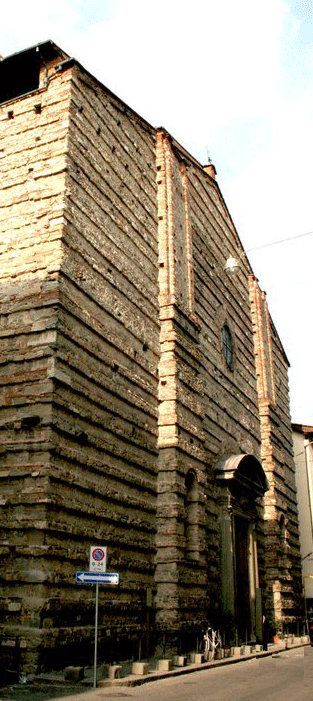The basilica of 'la Madonna dell'Umiltá' (the Madonna of humility) is situated on the site of the ancient church of Santa Maria Forisportae (literally 'outside the walls') whose name came from being built on the outside of the second line of city walls. On the 17th of July 1460 a miraculous event upset the town. From a fresco painting representing the Madonna of humility inside the Church, three subtle trickles of a "prodigious fluid" came from the forehead of the virgin. According to the chronicle, the event "continued for many days" and transformed the church into a pilgrimage destination where people came to honor the sacred image that was performing various miracles "giving pace to the lame, sight to the blind, amd other mercies"
Soon it was considered necessary to build a new, bigger building to worthily host the 'Miraculous Madonna' which had been done by an unknown painter in 1382. It was traditionally thought to have been painted by Giovanni di Bartolomeo Cristiani, but, according to recent studies, it was more likely to have been Paulo Serafini. The painter placed the Madonna, sitting on a pillow while breastfeeding her baby, like a common mother, instead of placing her on a throne like a queen. The project of the new sanctuary was given to the Florentine architect Giuliano da Sangallo in 1492, probably on the order of Lorenzo the Magnificent (Lorenzo de' Medici). The architect asked the Pistoiese Ventura Vitoni, who was also the master builder of the site, to produce the scale model of the church and construction eventually began on the 2nd of September 1495. During the following years, Antonio da Sangallo, brother of Giuliano and Antonio del Pollaiolo also took part in the contruction with the cooperation of workers from Lombardy and stone masons from Settignano. After the death of Ventura Vitoni in 1522, the building, with the vestibule completed but halted at the second level of the large octagonal room, was interrupted for almost forty years, during which time all the different projects for the dome failed. Finally in 1561, after the umpteenth request from the citizens of Pistoia, Cosimo de' Medici gave 9000 scute for the completion of the Cupola by Giorgio Vasari. Completed in 1570, the cupola needed serious structural repairs after only five years, probably due to the weight of the lantern, therefore new works were assigned to the architect Bartolomeo Ammannati, who also took care of moving the 'miraculous fresco' from the Church of Santa Maria Forisportae to its new home where it was placed at the main altar, which had been partially completed by Piero Tacca. The church was consecrated on the 31st of December 1582, becoming a place of great devotional attraction and in the course of time, it was enriched by prestigious work of arts and precious liturgical objects.

Soon it was considered necessary to build a new, bigger building to worthily host the 'Miraculous Madonna' which had been done by an unknown painter in 1382. It was traditionally thought to have been painted by Giovanni di Bartolomeo Cristiani, but, according to recent studies, it was more likely to have been Paulo Serafini. The painter placed the Madonna, sitting on a pillow while breastfeeding her baby, like a common mother, instead of placing her on a throne like a queen. The project of the new sanctuary was given to the Florentine architect Giuliano da Sangallo in 1492, probably on the order of Lorenzo the Magnificent (Lorenzo de' Medici). The architect asked the Pistoiese Ventura Vitoni, who was also the master builder of the site, to produce the scale model of the church and construction eventually began on the 2nd of September 1495. During the following years, Antonio da Sangallo, brother of Giuliano and Antonio del Pollaiolo also took part in the contruction with the cooperation of workers from Lombardy and stone masons from Settignano. After the death of Ventura Vitoni in 1522, the building, with the vestibule completed but halted at the second level of the large octagonal room, was interrupted for almost forty years, during which time all the different projects for the dome failed. Finally in 1561, after the umpteenth request from the citizens of Pistoia, Cosimo de' Medici gave 9000 scute for the completion of the Cupola by Giorgio Vasari. Completed in 1570, the cupola needed serious structural repairs after only five years, probably due to the weight of the lantern, therefore new works were assigned to the architect Bartolomeo Ammannati, who also took care of moving the 'miraculous fresco' from the Church of Santa Maria Forisportae to its new home where it was placed at the main altar, which had been partially completed by Piero Tacca. The church was consecrated on the 31st of December 1582, becoming a place of great devotional attraction and in the course of time, it was enriched by prestigious work of arts and precious liturgical objects.



